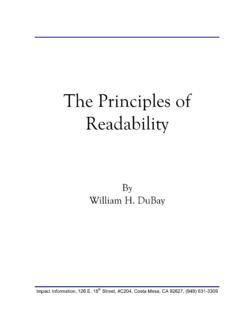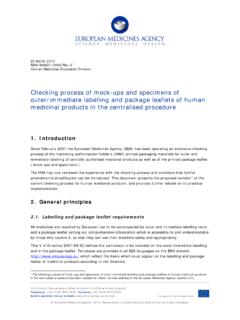Transcription of A Basic Overview of Hermeneutical Principles - Austin Bible …
1 A Basic Overview of Hermeneutical Principles Hermeneutics is the science and art of Biblical interpretation. It is a science because there are laws that guide it. It is an art because the laws must be skillfully applied. The term comes from the Greek verb meaning to translate, to interpret. This verb is found in John 1:42; 9:7; and Hebrews 7:2. The nouns , translation, interpretation, and , interpreter, also appear in the New Testament. At the heart of a literal hermeneutic is a desire to know the author s original intended meaning. The Scriptures are the absolute and objective standard for validating teaching (John 7:17; Acts 17:11). There must therefore be an absolute and objective method for interpreting and understanding the Bible . A literal hermeneutic is that method, as Jesus Himself illustrates (Matthew 4:4, 7, 10; 12:39-41; 24:15). Two Obvious Axioms of General Hermeneutics 1. The Bible communicates via human languages; therefore, it must be interpreted linguistically.
2 2. The Bible communicates God s thinking; therefore, it must be interpreted logically. God designed us to think and Biblical Christianity trains you to think (2nd Timothy 2:15). In context, we also will recognize that a faulty hermeneutic is destructive (2nd Timothy 2:14). Inductive Study What is truth? Pontius Pilate (John 18:38) There are two ways we can approach scripture: 1. Inductive facts 2. Deductive - premises, assumptions and presuppositions, something you assume is already true The question must be asked: Do we derive at the meaning of the text from the doctrine, or do we understand the doctrine because the text presents it? The Inductive method 1. Observation - What does it say? a. Who? Who was writing? To whom was the message originally written? Who are the people involved in the scenario? b. What? What s happening? What s said? Is it a command, an exhortation, a rebuke, a question, an answer, a prayer, a quotation of other scripture, something else?
3 What s the main point? What key words or phrases are used? What s the context? What literary style is being used? Is it narrative, conversation, parable, prophecy, poetry, a letter, or a sermon? c. When? Are there time references? Are there words related to the past, present, or future? Look for words like after, until, then. d. Where? Are there locations mentioned towns, roads, rivers, mountains, regions, or other landmarks? e. Why? Are there any clues about why things are being said or done? f. How? Is there an explanation about how things are done? 2. Interpretation - What does it mean? a. Interpret Literally - What did the original author intend? b. Interpret Grammatically Obey the laws of grammar, look for the plan sense. c. Interpret Historically How would the original audience understand it? d. Interpret Contextually How does it fit into the surrounding verses and the whole book? e. Interpret Scripturally Compare scripture with scripture. 3.
4 Application - What do I do with it? a. Does the text have an application for me? Primary or secondary? b. How do I make application? c. Proper application is built on proper interpretation (2nd Timothy 2:15). d. Submit in humility to the scriptures (2nd Timothy 3:16-17). Some Practical Exercises in Hermeneutics 1. The Bible interprets itself (Matthew 13:1-9, 19-23; Revelation 1:12-20; Daniel 2). 2. Jesus and Paul used a literal hermeneutic (Genesis 1; Matthew 19:4-6; Romans 5:12ff). 3. When the plain sense makes sense, don't look for any other sense (Isaiah 20). 4. Looking at context (Ezekiel 4:9). Languages of the Bible The Bible was originally written in Hebrew and Aramaic (Old Testament) and Koine Greek (New Testament). The study of these languages is by no means reserved for pastor-teachers, rather they should be studied by all students of the word. One reason for this is our need to interpret linguistically. Another is that no translation is perfect.
5 Types of English Translations 1. Formal Equivalence Essentially literal translation with a goal of interpreting grammar but precluding theological considerations. a. NASB b. NKJV c. KJV d. ESV 2. Dynamic Equivalence Non-literal approach to translation with the goal of greater readability ; loss of original intent and theological bias result. a. NIV b. NLT 3. Optimal Equivalence An essentially literal approach which combines formal equivalence with the maximum transfer of both the words and thoughts contained in the original. a. HCSB 4. Paraphrase A completely subjective interpretation of scripture without regard to the original intent of the authors. a. The Message b. The Living Bible 5. A Translation Comparison a. John 3:36 b. John 15:2 c. 1st Corinthians 5:11 d. - 1st John 3:9 e. - James 2:14 Language Tools 1. Complete computer based Bible study a. Logos Bible Software b. E-sword - 2. Old School print materials a.
6 Lexicons such as BDAG and Brown-Driver-Briggs b. Strong s Concordance c. Commentaries These can be very helpful at times and a misleading hindrance at others. d. Word Studies 3. Language Textbooks a. Greek Elements of New Testament Greek by Jeremy Duff b. Hebrew Introducing Biblical Hebrew by Allen P. Ross Recommended Reading 1. Living by the Book by Howard G. Hendricks 2. How to Master the English Bible by James M. Gray 3. A Syllabus of Studies in Hermeneutics by Rolin Thomas Chafer 4. Biblical Hermeneutics by Jacob Elisee Cellerier 5. Principles of Interpretation by Clinton Lockhart








